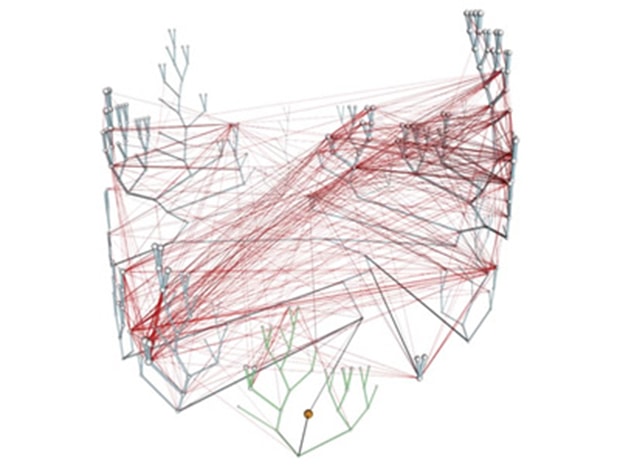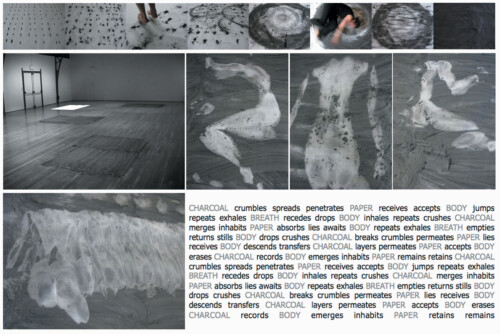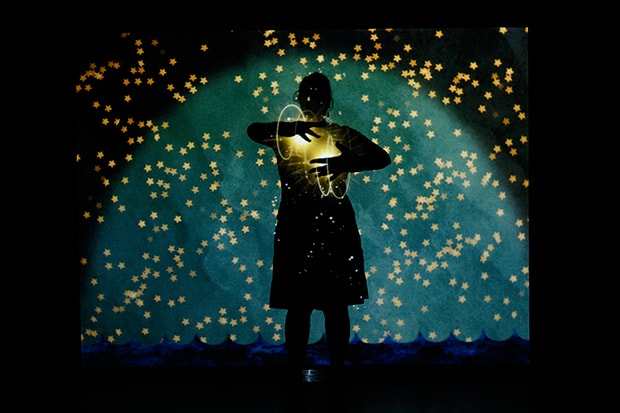Keeling. Ferguson: Affective Labor and Surplus Populations
Transdisciplinarities work out and among urgent, ranging, and competing forms of authority and assessment, under terms of current global restructuring, academic and otherwise.
Not everyone uses the term transdisciplinary in such a historically urgent and materially located way. For some, it is just another term for multidisciplinary or interdisciplinary—that is, for scholarship or projects in which disciplines and their experts collaborate, or in which intellectual themes and issues necessitate travels among and between disciplines. Still, competing authorities play roles in both of these, certainly. What sort of project of multiplicity is transdisciplinarity? What sorts of “double consciousness” might it array in which political economies?
Gregory Bateson used to say, in figuring what today we might call “distributed being,” we don’t end at our skin. Like the double bind, considered retrospectively, such a statement triggers a frisson of risk, concern, critique, anomaly, perhaps misrecognition, across social worlds in a range of pastpresents. “Skin,” at this moment in time, has so many different meanings and associations amid diverging archives and actions among knowledge worlds that the dramatically different implications for considering what it means to say to any particular group of people that we do not end at our skin, becomes an example itself of transdisciplinary movement across knowledge worlds. What sort of boundary object is this “skin”? Engaging and networking such a “riot of association,” to use a term I learned from Michael Moon’s work on “pulp affect” artist Henry Darger, comes to be the work to take up in that something we might provisionally call a posthumanities.
For a transmedia philosopher and analyst such as Kara Keeling, a book is a wormhole into this sort of transdisciplinary universe—there, many media collaborate without consensus; there, human affect labors among litanies for survival. A fantasy soundtrack companions the book, each chapter cautioned and referenced by songs whose lyrics advise wariness, “providing The Witch’s Flight with an affective register that simultaneously exceeds and yearns …. [that] might propel one into a ‘lyricism of the surplus’ that, while evading currently accessible common senses, still can be felt–like an intuition or premonition, something unseen, but nonetheless present(ly) (im)possible. The end of the world …. Work with me.”1
With the term “surplus,” Keeling relays the work of Rod Ferguson’s queer-of-color critique as she looks to demonstrate “the perceptual (and cognitive) processes demanded and engendered by globalizing capital.”2 Keeling and Ferguson collaborate here in working out how it is that human affect and a political economy of acquiring body parts from the skin’s edge are agencies of valorization, that is to say, of pricing, of valuing, of mobilizing labor.3 These may also entail polymorphously perverse disruptions of social hierarchies (across at least race, gender, class, sexuality) that arise with surplus populations, those “relatively redundant working populations … [that are] superfluous to capital’s average requirements for its own valorization.”4
Agencies of capital here are those worldly processes of economic systems articulating and distributed among, but not reproducing the powers of the state, or of community, family, or nation. Other agencies matter here too: sensory-motor apparatus and affectivities, thinkings and memory-images distributed across people and media. Exactly how lively or “sensitive” body parts in sensory-motor schemata can be to survive is at stake. Numbing out among media is a possible response to layered double-bind systems ranging from the confusing to the intolerable, and play among media is one training ground for political struggle that properly bypasses Reason.5 Keeling’s transmedia tracing of queer blaxploitation crossed with queer liberalism plays with the image of the black femme as figured by actor Pam Grier. Grier’s image has its existence halfway between its being and its representation, in a pastpresent trajectory across political economies. In a moment of economic retrenchment, 1970s Hollywood reaches out for young urban black audiences (in a multiplication of surplus) with Pam Grier as Foxy Brown, a “stud broad” reproving her heterosex, or as Coffy, a queered black femme, in terms that defy raced and classed heteronormativity. This memory-image holds open this raced queerness into television’s The L Word (2004-2009), even though Grier plays Kit Porter, the only heterosexual recurring female character.
Notice that an attention to the multiplication of surplus multiplies any critique of The L Word’s middle-class, primarily white milieu, or of its appeal to straight men, by requiring a multiplied consciousness of what is queerly valorized: “If Pam Grier is a locus of desire for both heterosexual males and … for lesbians such as the Lesbian Avengers’ lesbian partygoers, then her presence on The L Word is another way the series seeks to bring these populations together in a shared project of value production.”6 Whose “man” exceeds representation or exists halfway between it and a beingness queerly, materially other?
Barad. Ahmed. Alaimo. Hekman: Entangled Material Feminisms
The primary ontological units are not ‘things’ but phenomena–dynamic topologicalreconfigurings/entanglements/relationalities/(re)articulations …. Agency is not an attribute but the ongoing reconfigurings of the world.7
Knowledge making costs money. Increasingly, over the nineties and after, who pays for what sorts of knowledge making and where has become increasingly contentious in national agendas for innovation and economic positioning. Which surplus populations will be enrolled into which kinds of institutions for knowledge work becomes an element of global academic restructuring. A multiplication of surplus reorders the very names of institutions, from, say, polytechnics to new universities. Restructuring involves politicizing funding such that knowledge-making practices are subject to assessments and accountancies of various sorts. Academics find themselves having to explain to publics and governmentalities just what it is that they do and why it matters, as forms of justification for the uses of public and private funding.8
A posthumanities emerges out of an intellectual double bind of having to both address many diverging audiences simultaneously under the threat of survival, while also having to author knowledges as merely one of multiple agencies with very limited control. In this environment the mapping of messages onto audiences becomes increasingly tricky as authorial and receptive agencies, partial and highly distributed, require affective labors: sifting among authoritative and alternative knowledges, clarifying affiliations, inspiring trust.9 Feminisms are affected.
In 2008, in a virtuosic performance of layered critique, philosopher Sara Ahmed held out the boundary object, “material feminisms,” for inspection. Whose material was this? Which generations of feminisms were implicated? Which feminist communities of practice were affiliated in an inspection of “material feminisms,” and how? Which details were necessary to name others carefully? What contexts were backdrops for which founding gestures? Frustration, forgetting, unfairness, intensity, ethics, hope, and caring attention to detail were among the affective labors expended and demanded. Ahmed concludes the essay with:
In claiming to return to matter, we might then be losing sight of how matter matters in different ways, for different feminisms, over time. The gesture is a forgetting as well as a caricature. Of course, I have no doubt reduced the complexity of the work I am engaging with. I was compelled to write this piece–by frustration, I admit. If my argument against such gestures means anything it means this: when we describe what it is that we do, when we consider how it is that we arrive at the grounds we inhabit, we need to appreciate the feminist work that comes before us, in all its complexity. We don’t always have to make a return to earlier feminist work, but if we represent that work as being this or that, then we need to make that return. Such a return would be ethical: we should avoid establishing a new terrain by clearing the ground of what has come before us. And we might not be quite so willing to deposit our hope in the category of “the new.”10
As a professor of race and cultural studies in the department of media and communications (Goldsmiths, University of London) concerned with “how bodies and worlds take shape;” “institutional cultures;” and “how emotions are attributed to objects, such that objects become sticky, or full of affective value,” Ahmed’s ability here to feel out and make explicit that irritable frustration that signals anomaly and tangles across communities of practice is itself “irritating,” that is to say, alive, reflecting and provoking affective labor, making edges and margins vibrate, setting media into responses and responsibilities.11
“Of course, I have no doubt reduced the complexity of the work I am engaging with.” Irritable relays of all sorts are set into motion by this very proper statement at the end of a critique inspecting some effects of reducing complexity. These words make explicit the hard work of elegance in explanation and of essentialism in critique, those strategic openings and closings of “black boxes” full of memory, “hyperlinks” to detailed generational or local knowledges, not-altogether-voluntary requirements to choose among grains of detail—all having to shape-shift when transdisciplinary knowledges travel in n-dimensions with and without human agencies. “One must wonder who is being evoked by this ‘we’, and to what extent this ‘we’ functions to interpellate the reader into a community that shares a common horizon (Have you forgotten where we have come from? Have I?).”12 Which side, which knowledge world, in what spacetime are “we” on, inside and outside of, bonding and othering?
How is something like a “posthumanities” at stake here, in what sort of “play”? That critique—in itself, about itself: intense certainly, and maybe irritably pleasurable? Meanwhile the interactive dynamisms, the metacommunications about affect and intensity ensure the sensations of groupings and competitions, their edges and affiliations among alliances and passions. Instead of resolution, tacit forgettings, or civil cooperations, what sorts of boundary objects value irritation?
Ahmed takes issue with a series of “Matter? not!” declarations by feminist physicist and onto-epistemologist Karen Barad in her essay, “Posthumanist Performativity: Toward an Understanding of How Matter Comes to Matter.”13 Ahmed worries that these and some other (black-boxing) speech acts are only caricatures of whole arguments, of whole (disciplinising?) archives, and that they are not conducted at the proper grain of detail, “not attributed to somebody. The new materialisms takes shape by the mobility and detachability of this ‘not.’”14

A mobility and detachability of such “nots” provokes a frisson: what if it is signaling cat’s cradle relays across string-figuring, knotted SFs, that is to say, science feminisms? What if the worlding here needs to scope and scale along ranges of detail, indications of shifts from one knowledge world to another assemblaged through boundary objects? Ahmed’s critiques might well be held to properly apply to the volume in which Barad’s essay is reprinted in 2008, to the very linkages among materialities and materialisms collected in literary theorist Stacy Alaimo’s and political scientist Susan Hekman’s edited volume Material Feminisms (2008). The debate as such becomes then a demonstration of who gets to say in which knowledge worlds material linkages were already in place, even routinized, among media, feminisms, technosciences, bodies, disciplines, canons, glossaries, timeframes, economies of culture, apparatuses, and principle actors and actants. For Alaimo and Hekman, even knowing that such linkages exist could not be assumed for their disciplinized archives of reference and must be conscientiously made explicit as “new” across three decades of feminist work backgrounded or marginalized in disciplines such as political theory. For Ahmed the assertion as “new” of work now a decade or more “old” is a gesture that, in a routinized rhetoric about feminisms, or as a intellectual gesture that opened out upon some grounding for a “new” field, both promoted and simultaneously erased some of the very work it seemingly valorized. Intellectual infrastructures were variously assembled or stacked, and the density of detail was either extensively scaled out, or intensively scoped closely among specific intellectual communities. Attention, in this case, not only narrowed the range of possible material feminisms over time, but also altered the grain of detail, resulting in differential focus for items of attention.
“Apparatuses are not inscription devices [one whole archive of studies repositioned here], scientific instruments set in place before the action happens, or machines that mediate the dialectic of resistance and accommodation.”15 All this “not”-ing sets the focus of the lens used in examination here, alters the grain of detail deliberately (if perhaps dismissingly, although that is not necessarily the case), and requires a different horizon of “we,” one that pulls way back to include forms of matter as they appear in alternate knowledge worlds. “In my further elaboration of Bohr’s insights, apparatuses are not mere static arrangements of the world, but rather, apparatuses are dynamic (re)configurings of the world, specific agential practices/intra-actions/performances through which specific exclusionary boundaries are enacted. Apparatuses have no inherent ‘outside’ boundary. This indeterminacy of the ‘outside’ boundary represents the impossibility of closure–the ongoing intra-activity in the iterative reconfiguring of the apparatus of bodily production. Apparatuses are open-ended practices.16
One of my favorite not-quite-politically-correct quotations from Leigh Star is this one: “We honestly believe that there are no positions that are epistemologically superior to any others. But I do at the same time argue with and try to overthrow those I don’t agree with! Relativism in this sense does not imply neutrality–rather, it implies forswearing claims to absolute epistemological authority. This is quite different from abandoning moral commitments.”17 I brazenly detach these words from their original context and mobilize them all together for my own irritating purposes: at alternate levels of globals and locals, I both reduce and add to their complexity, claiming the quotation signals conscientious play with double or multiple consciousness. And I think of this quotation in terms of growing boundary objects that allow one to inhabit the terrain of double binds honorably, playfully, companionably, and irritatingly. Thus at one level of contradiction intensively inhabiting particular communities of practice with close horizons and sharp affiliating disciplinizations, while simultaneously also willingly scoping out extensively—to be curious and value how claims to epistemological authority operate and how comparative relativisms can be accountable. I can irritatingly, passionately disagree with, say, the use of “intersectionality” by a particular community of practice, yet conscientiously value and participate in a history of multiple intersectionalities, standpoints, and antiracist practices, with varying horizons of membership, discipline, and generation, transnational venues and political contexts, philosophical and theoretical lineages, and so on, in n-dimensions and among historical knowledge-power apparatuses not wholly “human” or “humanist.”
- Kara Keeling, The Witch’s Flight: The Cinematic, the Black Femme, and the Image of Common Sense (Durham: Duke UP, 2007): 6-7. “Smiling Faces Sometimes” is the companion song for Chapters 1 and 2. [↩]
- Keeling 2007: 11. [↩]
- Keeling 2007: 13; Roderick A. Ferguson, Aberrations in black: Toward a queer of color critique (Minneapolis: Minnesota UP, 2004: 11-18. [↩]
- Marx, Karl, Capital, vol. 1, trans. Ben Fowkes (London: Penguin, 1990 [1863]): 782, quoted in Ferguson 2004: 15; ellipsis altered. [↩]
- Keeling 2007: 14-20. [↩]
- Keeling 2007: 115. [↩]
- Karen Barad, “Posthumanist Performativity: Toward an Understanding of How Matter Comes to Matter,” Material Feminisms, eds. Stacy Alaimo and Susan Hekman (Bloomington: U of Indiana P, 2008 [2003]) 135. [↩]
- Sheila Slaughter and Larry Leslie, Academic Capitalism: Politics, Policies, and the Entrepreneurial University (Baltimore: Johns Hopkins UP, 1997); Sheila Slaughter and Gary Rhoades, Academic Capitalism and the New Economy: Markets, State, and Higher Education (Baltimore: Johns Hopkins UP, 2004). [↩]
- Katie King, Networked Reenactments: Stories Transdisciplinary Knowledges Tell (Durham: Duke, forthcoming). [↩]
- Sara Ahmed, “Open Forum: Imaginary Prohibitions: Some Preliminary Remarks on the Founding Gestures of the ‘New Materialism,'” European Journal of Women’s Studies 15.1 (2008): 36. [↩]
- Sara Ahmed, “Research Profile,” Goldsmiths, University of London, faculty webpage. Retrieved 7 Sept. 2011. [↩]
- Ahmed 2008: 26. [↩]
- Barad 2008 [2003]. [↩]
- Ahmed 2008: 35. [↩]
- Barad 2008 [2003]: 134. [↩]
- Barad 2008 [2003]: 134, emphasis in original. [↩]
- Susan Leigh Star, “Introduction,” Ecologies of Knowledge: Work and Politics in Science and Technology (Albany: State U of New York P, 1995) 22. [↩]






